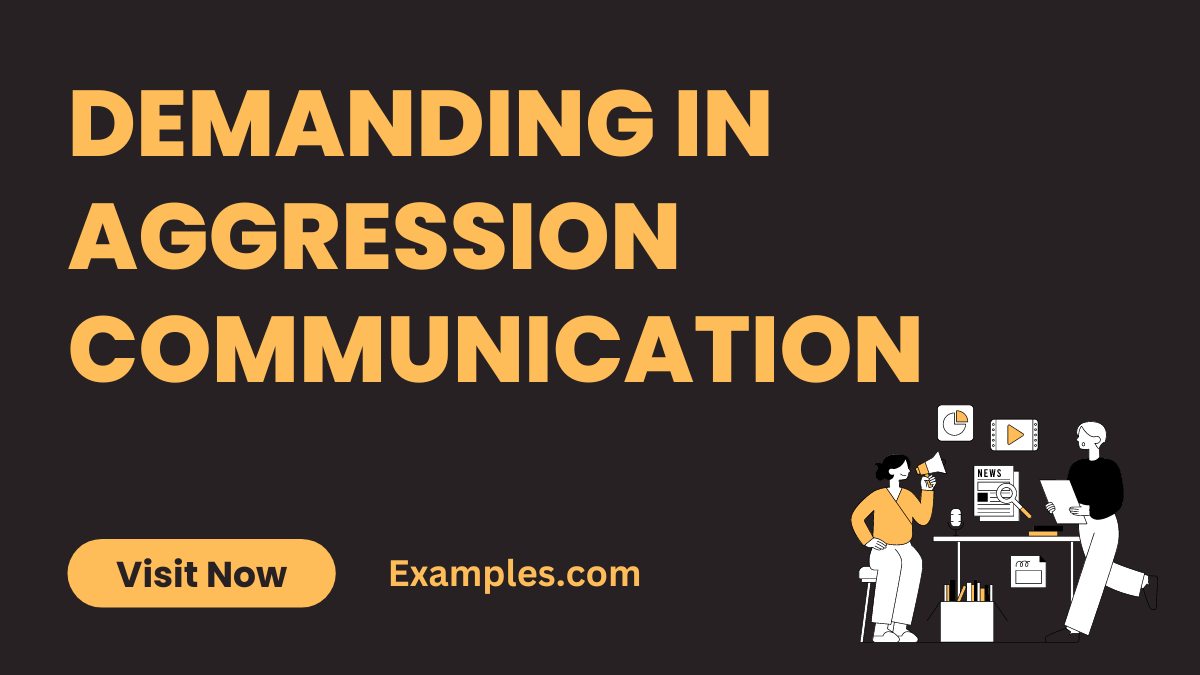19+ Demanding in Communication Examples
Navigating the delicate balance of expressing needs assertively without straying into aggressiveness is crucial in effective communication. This comprehensive guide explores the nuances of demanding in communication, providing practical examples and strategies. It delves into the art of making requests in a manner that is both clear and respectful, ensuring your voice is heard while maintaining healthy relationships. Through real-life scenarios and expert advice, learn how to communicate your needs effectively, enhancing both personal and professional interactions. This guide is an indispensable resource for anyone looking to refine their communication skills with assertiveness and tact.
What is Demanding in Communication?

Demanding in communication refers to a style where a person insists on their requests or needs assertively, often without considering others’ opinions or feelings. This communication style can be characterized by a commanding tone, direct language, and often a lack of willingness to negotiate or compromise. While being clear and assertive is positive, demanding communication crosses into being overly forceful or imposing, which can lead to negative interactions and conflicts in both personal and professional settings.
20 Demanding in Communication Examples
In the realm of communication, the challenge lies in expressing needs and expectations without crossing into aggression. This guide explores demanding in communication, focusing on how to articulate requests clearly and respectfully. It’s crucial in both personal and professional contexts to communicate demands effectively, ensuring they are heard and acted upon while maintaining positive relationships.
- “I need this report by tomorrow morning; please prioritize it.” – Direct yet polite, this example shows how to assert a deadline without being aggressive.
- “It’s essential that you attend this meeting; your input is valuable.” – This sentence emphasizes the importance of presence in a meeting, making it a respectful yet firm request.
- “Please complete the task as instructed; it’s crucial for the project’s success.” – This communicates the importance of following instructions for the greater good of the project.
- “I expect this issue to be resolved by the end of the day.” – A clear deadline is set, expressing urgency without being rude.
- “Your participation in this training is mandatory; please make arrangements to attend.” – The necessity of attendance is stressed, yet it’s framed as a requirement rather than a personal demand.
- “We require your response by Friday to proceed further.” – Sets a clear time frame for a response, indicating its importance for progression.
- “It’s important that we stick to the agreed budget for this project.” – Reinforces financial boundaries firmly but respectfully.
- “Please ensure your section of the report aligns with the guidelines.” – A polite reminder to adhere to standards.
- “I need your full attention during this presentation.” – A direct request for undivided attention, crucial in a professional setting.
- “Complete the form accurately to avoid any processing delays.” – Encourages precise action to prevent future issues.
- “Your timely feedback on this matter is essential.” – Highlights the importance of prompt responses.
- “Ensure all safety protocols are followed without exception.” – A non-negotiable demand emphasizing safety.
- “It’s imperative that you meet the quality standards set for this task.” – Stresses the need for quality work.
- “I expect thorough research to be done before our next meeting.” – Sets clear expectations for preparation.
- “Consistent punctuality for these sessions is required.” – Underlines the importance of being on time.
- “Adherence to the project timeline is non-negotiable.” – A firm stance on following schedules.
- “I require a detailed analysis, not just a summary.” – Specifies the depth of work expected.
- “Your cooperation in this process is crucial for its success.” – A polite yet firm request for collaboration.
- “Please limit your presentation to 10 minutes, as per the schedule.” – A clear directive maintaining the agenda.
- “Address these customer complaints promptly and efficiently.” – A command for quick and effective action.
Examples of Demanding Communication for Professionals
Demanding communication in a professional setting often involves assertive, direct language, and a tone that conveys urgency or authority. This style is used to ensure tasks are completed efficiently and goals are met. However, it’s important to balance demanding communication with respect and understanding to maintain healthy workplace relationships.
- “I need this report by 5 PM today, no exceptions!” – Sets a strict deadline with clear expectations.
- “You must follow my instructions exactly as I said.” – Emphasizes the importance of precise adherence to directions.
- “This task is your top priority right now.” – Clearly prioritizes tasks, leaving no room for ambiguity.
- “I expect better results next time.” – Expresses dissatisfaction and sets higher expectations for future performance.
- “Do not deviate from the plan we agreed upon.” – Insists on sticking to a pre-determined plan or strategy.
What are Demanding in Communication Skills?

Demanding communication skills involve assertively stating needs or expectations with an authoritative tone, often used to ensure that tasks and objectives are clearly understood and acted upon. These skills include:
- Clarity in Expression: Clearly articulate what is needed or expected. Avoid ambiguity to ensure that the message is understood as intended.
- Assertiveness: Communicate your needs confidently without tipping into aggression. Assertiveness involves respecting both your own rights and those of others.
- Authority: Command respect and compliance through your communication style. This involves a balance of firmness and fairness.
- Conciseness: Being brief yet comprehensive is key. This approach minimizes confusion and keeps the focus on the main points. A concise message is more likely to be understood and acted upon effectively.
- Non-Verbal Cues: Your body language and tone can significantly reinforce your message. A confident stance and assertive tone can convey authority and seriousness.
- Feedback Mechanism: Establish a system for receiving and addressing responses to your demands. This can involve regular check-ins or feedback sessions, ensuring a two-way communication flow.
- Adaptability: Tailor your level of demand according to the situation and the individual. Understanding the context and the people you are communicating with can make your demands more effective and less likely to be met with resistance.
Mastering these skills can lead to more effective leadership and management, ensuring that objectives are met efficiently.
What is the Importance of Demanding in Communication?
Demanding communication is important for effective leadership and management. It ensures that goals and deadlines are clearly understood and met, which is essential in fast-paced or high-stakes environments. It helps in maintaining standards and accountability. However, it’s important to balance demanding communication with empathy and respect to avoid negative impacts on team morale and collaboration.
- Clear Direction: Providing clear and unambiguous instructions or expectations is crucial in a professional setting. Demanding communication, when clear and direct, eliminates confusion and ensures that everyone is on the same page.
- Efficiency: This communication style can lead to quicker decision-making and action-taking. It cuts through indecision and prolonged discussions, leading to faster implementation of plans and strategies.
- Leadership: Strong leadership often requires the ability to communicate demands effectively. It helps leaders guide their teams towards goals with a clear vision and decisive actions.
- Boundary Setting: Demanding communication can be very useful in setting and enforcing boundaries or standards in both personal and professional relationships. It helps in establishing clear limits and expectations.
- Conflict Resolution: In situations where conflict arises, demanding communication can be effective in bringing about a resolution. Clear, decisive action can help resolve disputes before they escalate.
- Motivation: When used appropriately, demanding communication can serve as a powerful motivator. It can push individuals to perform better, especially in high-stakes environments.
- Task Completion: This style ensures that tasks are completed within set parameters or deadlines. It can be particularly useful in project management where timely delivery is critical.
Understanding the importance of demanding communication helps in applying it effectively, balancing assertiveness with empathy and respect.
How to Improve Demanding in Communication?
Improving demanding communication involves refining the way assertive directives are given, ensuring they are clear, respectful, and effective.
- Balance Firmness with Respect: Striking a balance between being assertive and respectful is key. Clearly state your needs but also consider and acknowledge the viewpoints of others.
- Clarify Expectations: Ensure your demands are not just clear, but also achievable. Ambiguity can lead to misunderstandings and non-compliance.
- Explain the Reasoning: People are more likely to respond positively if they understand why a demand is being made. Providing context and rationale can help.
- Practice Active Listening: Show that you value others’ input. Be willing to adjust your approach based on the feedback you receive.
- Maintain Professionalism: Even when asserting your needs, maintain a professional demeanor. This helps in keeping the conversation productive.
- Use Positive Reinforcement: Recognize and appreciate when your demands are met. Positive reinforcement can lead to better compliance in the future.
Tips for Effective Demanding in Communication
Effective demanding in communication requires a strategic approach to ensure that assertiveness is productive and not counterproductive.
- Set Realistic Expectations: Ensure that your demands are achievable, aligning with the skills and resources available. Unrealistic demands can lead to frustration and failure.
- Prioritize Communication: Clearly and concisely state what you need, focusing on the most critical aspects. This helps in avoiding confusion and ensures that important points are understood.
- Foster a Supportive Environment: Create a workplace where demands are associated with personal and professional growth, not just added pressure.
- Lead by Example: Demonstrate the behavior and work ethic you expect from others. This builds credibility and respect.
- Build Strong Relationships: Cultivate trust and respect to make your demands more acceptable and reasonable to your team.
- Follow Up: Regularly check on progress and understanding. This shows you are engaged and supportive of the work being done.
In conclusion, Demanding in Communication plays a critical role in assertive dialogue, particularly in leadership and decision-making scenarios. Employing a demanding tone judiciously can convey urgency and importance effectively. However, it’s crucial to balance assertiveness with empathy and understanding to avoid potential miscommunications or conflicts. By mastering this communication style, individuals can navigate complex interactions with greater confidence and efficiency.



